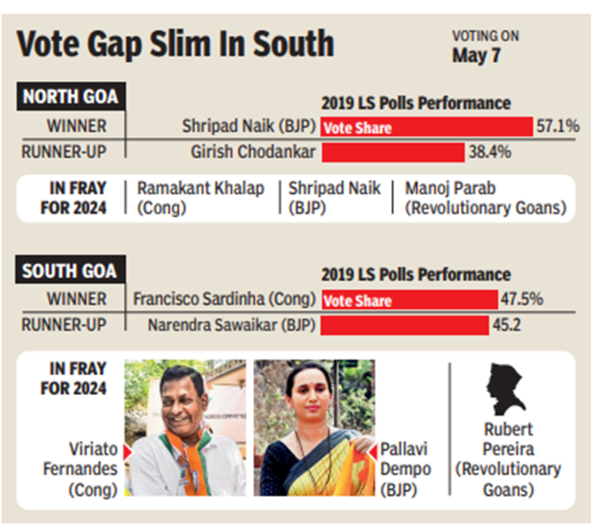The numbers are in favor of the BJP. .
The BJP insists that its OBC face, five-time MP and Union Minister Shripad Naik belongs to the Bhandari community that dominates North Goa’s Lok Sabha constituency, while both the Congress and RG have played the time-tested card of having Hindus — Ramakant Khalap and Manoj Parab from the north and Christians Viriato Fernandes and Rubert Pereira from the south respectively.

In northern Goa, two septuagenarians – Khalap (76) and Naik (71) – face off again after 25 years.but it is south goa The BJP has fielded a political novice and female candidate in the constituency, vying for a congressional seat against Navy veteran-turned-activist-turned-politician Capt. Viriato Fernandez.
Pallavi Dempo, a businesswoman from one of Goa’s oldest business families and the richest candidate in the third phase of general elections slated for May 7, has a net worth of about Rs 1,400 crore. This was her first foray into politics. For the BJP, this is also the first time that the party is fielding a woman candidate from the Goa Lok Sabha constituency.
On the face of it, the BJP appears to be holding on to the South Goa seat with ease. Soon after the 2022 assembly elections, the BJP orchestrated the defections of eight of the 11 Congress MLAs and has effectively taken control of 15 of the 20 parliamentary divisions.
But beneath the veneer of high-decibel optimism, party managers are concerned about an undercurrent of insecurity among “renegade” MLAs, especially those representing predominantly Christian constituencies. The saffron party, which has won the seat only twice, in 1999 and 2014, knows that sometimes numbers alone are not enough.
Felipe Neri Cardinal Ferrao, Archbishop of Goa and Daman, issued a notice to all dioceses, priests and Catholics asking them to vote for secular candidates who “uphold the values of the Constitution” The underlying trend of discontent and distrust in the party, as well as its inability to make inroads in the Christian-dominated Salsette talukas, has led to unease in the BJP camp.
In the 2019 polls, Salsette taluka, which has only eight assembly constituencies, gave the Congress a lead of nearly 50,000 votes, allowing its candidate to win the southern seat by about 10,000 votes. While the BJP has been able to limit the joint opposition to four MPs in Salsette, the party knows that lawmakers turning to saffron will not necessarily translate into more votes.
The BJP realized that its vote share fell by 2.2 percentage points to 51.9% in 2019, while the Congress’s vote share increased by 6.6 percentage points to 43.6% and the AAP received 3.1% of the vote.Now, with AAP and other miscellaneous parties becoming part of the Hindu bloc, the BJP is desperate to regain its lost vote share and cross the 55% mark to easily retain two seats
In the north, Naik has been battling anti-incumbency forces, but working in his favor is the fact that the PPP holds 90% of the 20 parliamentary seats. While the BJP is confident of retaining the seat, it hopes to reverse a 1.1 percentage point decline in turnout in 2019 and raise it to above the current 57.1%. With the support of the MGP (Maharashtra Vadigum Thakur Party), the BJP finds itself in a better position to get Naik compared to when it backed the Congress in the last elections. A record sixth consecutive term in North Goa.
In the smallest state, where personal politics trumps party politics, no wonder political parties take cues from the central leadership during the Lok Sabha elections.
Armed with Prime Minister Narendra Modi’s assurances, a “double-engine” government and the slogan of Viksit Bharat, the Bharatiya Janata Party is also emphasizing “nari shakti” through its women candidates. The Congress sought to frame the election in terms of “money power versus people power” and the fears of minorities under the BJP rule, while focusing on local issues such as Mahathir’s diversion, coal handling, railway duplexing and unemployment.
As two national parties battle it out in a “two-seat” state with 1.18 million voters, RG is trying to blend in with its hyper-local hyperbole. RG taps into the emotions of the people and attempts to evoke the loss of Goan identity and the struggle of Goans for survival.







